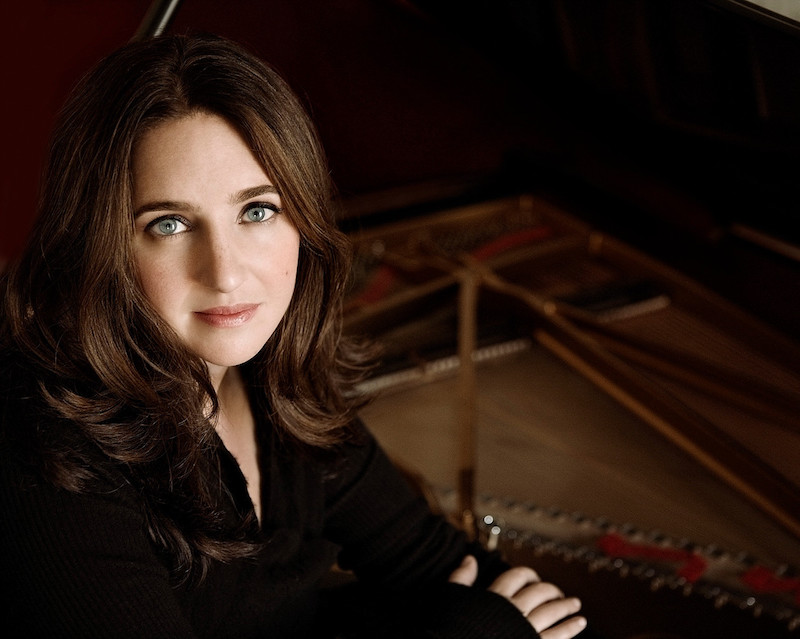At a revelatory concert Thursday night at Berkeley’s First Congregational Church, Simone Dinnerstein joined the New Century Chamber Orchestra for the premiere of Philip Glass’ Piano Concerto No. 3. It was an illuminating evening in which several themes stood out.
By cleverly interleaving seventeenth century and contemporary works, it was made clear to us that music is one long continuum. While that is often attempted in programming, this was the clearest that I can recall, and most of the credit for that deeper view was due to the intensity and exactitude of the New Century Chamber Orchestra and guest violinist Zachary De Pue. They poured themselves equally into the musics, ancient and modern, with such delight that it was our delight to watch and hear them.
In the second half Dinnerstein continued that theme with a deeply felt interpretation of Bach as a prelude to her powerful rendering of Philip Glass’ new concerto.

A second theme was unity.
One year after the departure of Artistic Director Nadja Salerno-Sonnenberg (a gifted and forceful soloist), it was gratifying to see that De Pue, as first violinist, promoted the original vision of this ensemble as a conductor-less group. Formed by Stuart Canin in 1992, one of their premises is to bend their ears and eyes to each other rather than to a baton.
“I miss Nadja,” said a music reviewer at intermission. “I miss her… sparkle. This conductor is more of a …” He paused for lack of a word. “More of a team player?” I asked, thinking of how they had traded in dazzle for a group that turns listening into art.
And listen they did, with flourishes that were telepathic and leans that rounded every long note into a sumptuous delight.
They began with Henry Purcell’s Chacony in G Minor, written in the 1680s and re-arranged by Benjamin Britten in 1947. This was a dance form, and the chamber orchestra turned it intimate and visceral. As I watched the strings sway into the rhythms, (and all were standing except for the cellos), I looked at De Pue’s violin, a crisp piece of workmanship, and then saw in the program notes that it was made by Gagliano of Naples in 1757. That amber-stained bit of spruce and maple was played and handed down from musician to musician for longer than our country was promoting its ideals!
And that reinforced the sense of continuity of musical striving. They swept into Bryce Dessner’s Aheym with blistering attacks, notes front-loaded into explosions of sound. This was a variation of the persistent under-structures of minimalism, but less formal and more imbued with rock.
Those structures slowly broke apart and evolved, then turned meditative and slow. Despite its sturdy backbone, this was essentially a work of nostalgia, and the New Century went as deeply into this modern work as they had explored Purcell’s sweeps in the minor mode.
And then a return to the past, with Francesco Geminiani’s Concerto Grosso No. 12, another dance form with the strings gilded by the soft jangle of harpsichord. Here again we had lilting measures and stately passages and spirited bowing, and, if one listened a little harder, the keys to the future.
After intermission Dinnerstein joined the strings for J.S. Bach’s Keyboard Concerto No. 7, and it was immediately apparent that her clarity and passion embodies that bridge of musical continuity. The exacting power of her playing was supported by the richness of the strings, so that the piano was sometimes submerged and sometimes soaring. Dinnerstein came to fame with her interpretation of Bach’s Goldberg Variations, and the high arch of her fingering gave her piano the lucidity of a harpsichord, but with guts.
And that was a prelude for Philip Glass’ Concerto. Written in the past couple years as he approached his 80th year, this was a work that softened his trademark framework of busy sixteenths into an impressionistic and introspective exploration. There was a slow shifting architecture, the planetary precession of those busy sixteenths, but there were also moments of thunder and resolutions that stopped one’s breath. It slowed and turned dreamy, an homage to Arvo Pärt, according to Glass, with lots of bell-like sixths. That interval is what I think of when I hear Mozart’s duets, the sound of faith.
At the end it slowed and slowed and slowed, each phrase repeated as freshly as if for the first time, and with the enormous patience of age. We knew that we had heard something both deeply private and universal.
—Adam Broner
Photo, above, of Simone Dinnerstein; photo by Lisa Marie Mazzucco
